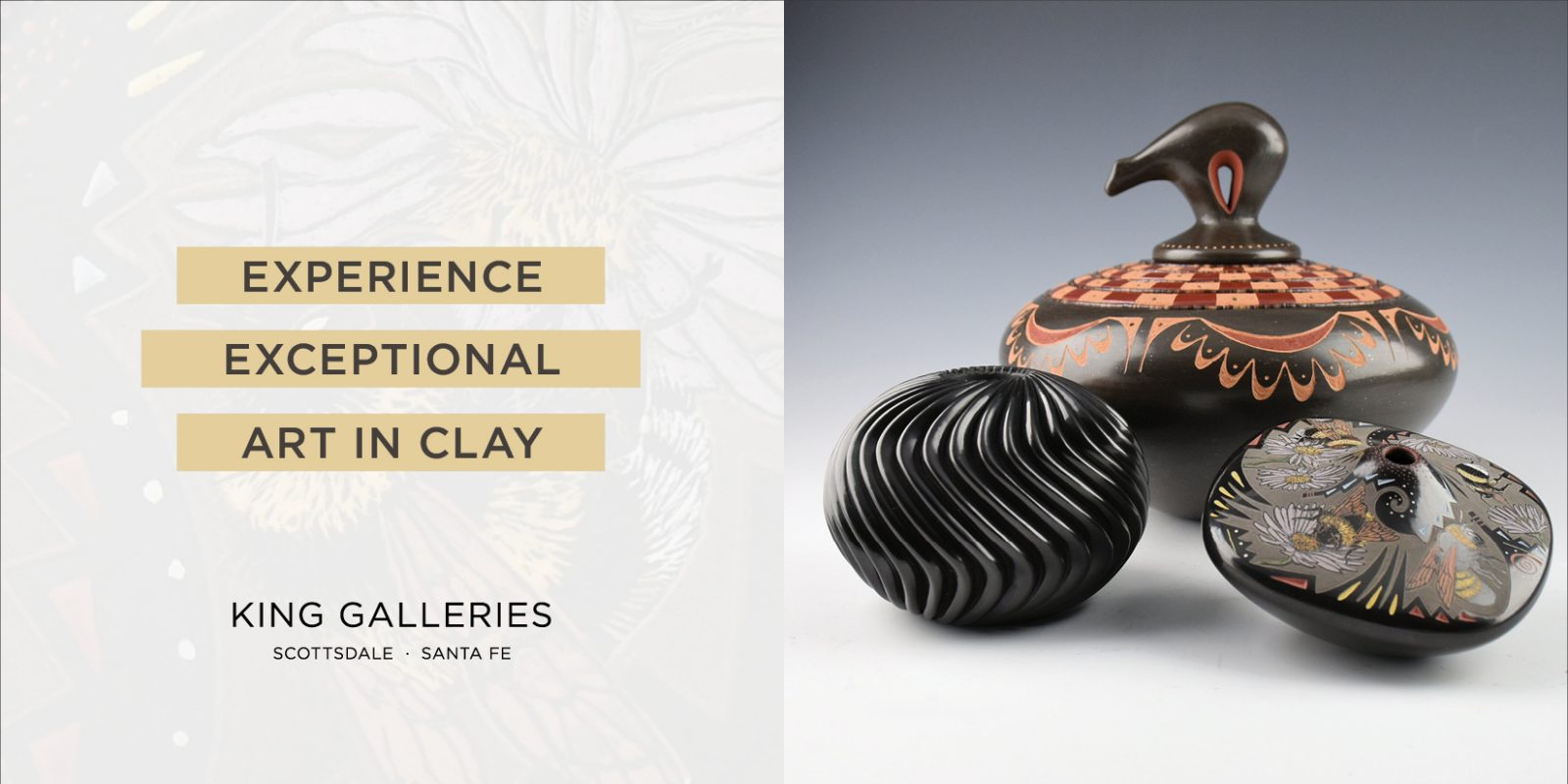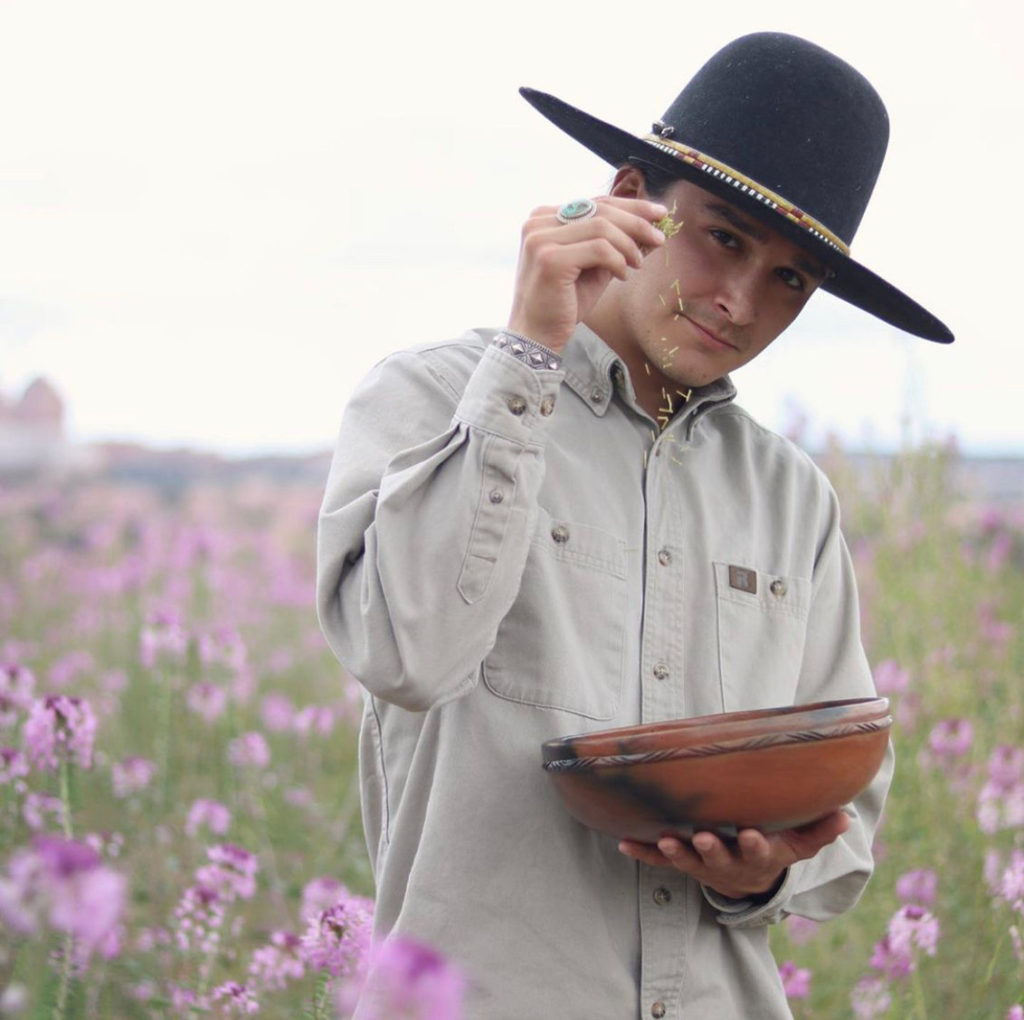Collector's Corner
THE CONFLUENCE OF TRADITION AND MODERNITY: The Ceramic Art of Jared Tso
One of the joys of collecting contemporary art, as opposed to historic works, is meeting the artists who created them. Over many years of collecting I have met quite a few of the artists whose work is in my collection and a number of them have become friends. So, in the summer of 2021, it was a great delight to meet Jared Tso, a young Navajo ceramic artist, at King Galleries in Santa Fe. I had a long conversation with Jared and he really impressed me as does his work. Although he is an emerging artist, Jared’s ceramics are already much coveted by savvy collectors who see in his work a combination of Navajo pottery traditions and Jared’s own modern ideas and explorations. In addition to being a ceramic artist and having earned a Master’s of Fine Arts – Ceramics, Jared also holds a degree in electrical engineering. He is an extraordinary young man.
Each of Jared Tso’s pieces is coil-built from native Navajo clay and traditionally burnished and fired. Inspired by classic Navajo pottery, Tso’s ceramics are exceptionally refined – thin-walled, with astonishingly smooth surfaces. Though the techniques used to produce them are traditional, each vessel is visually modernist.
Many of Jared Tso’s pieces are made using micaceous clay, which contains the mineral mica. Depending on how this type of clay is fired, interesting colors, which range from red to orange to gray, are produced by the smoke and fire,
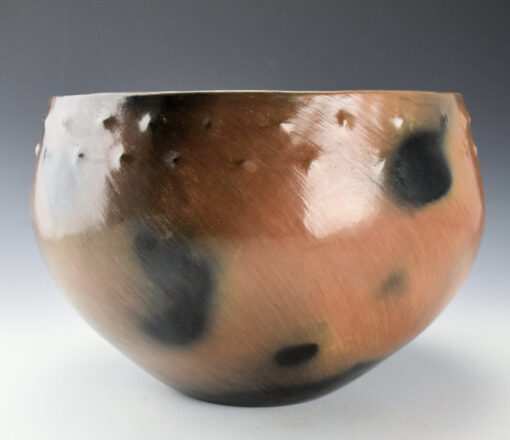
Traditional White Polished Bowl with Piñon Pitch Exterior by Jared Tso, Navajo, 9”w x 6.5”h (2021). Collection of E. J. Guarino.
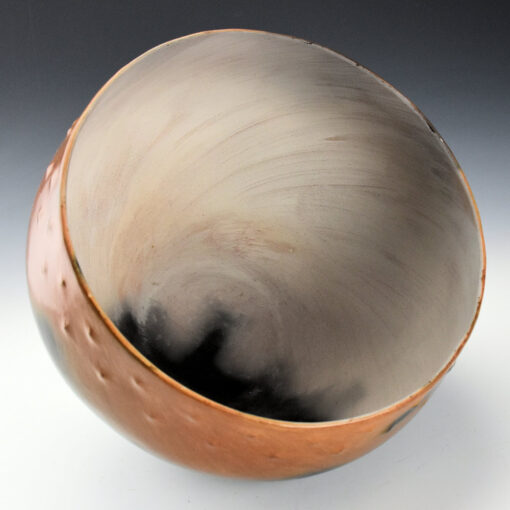
Traditional White Polished Bowl with Piñon Pitch Exterior – Interior.
Tso’s Traditional White Polished Bowl with Piñon Pitch Exterior is one of a series that are slipped with white clay rather than the usual red Navajo clay. Coil built and stone polished, the bowl has a swirl from rim to base as well as small raised protuberances around the neck. The traditional firing of this piece yielded a stunning coloration: The exterior, slipped with piñon pitch, has spectacular fire clouds while the interior progresses from black to white.
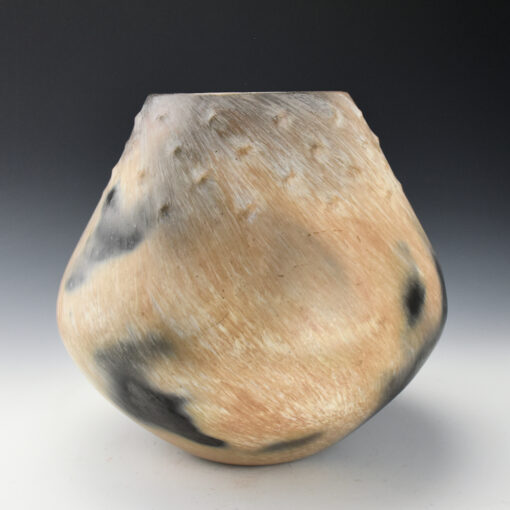
White Polished Jar with Piñon Pitch interior by Jared Tso, Navajo, 9” x 8.5” (2021). Private collection.
The White Polished Jar with Piñon Pitch Interior is another in a series of pieces that are slipped with white clay instead of red. The jar has a wide, sloping shoulder and, as with all of Jared Tso’s ceramics, it is stone polished, creating a swirl from the rim to the base. Like the bowl he created, Tso included raised protrusions around the neck of this piece. The firing of the jar created stunning colorations that blend from black to white. This piece, like all of Tso’s ceramics, employs traditional techniques, yet the work is highly refined and reflects a contemporary sensibility.
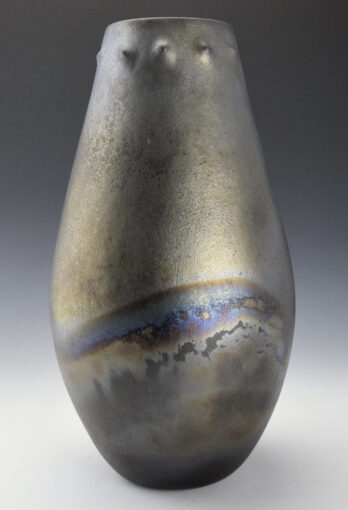
Tall Micaceous Jar with “Rainbow” Firing by Jared Tso, Navajo, 6″ x 12” (2021). Private collection.
For anyone familiar with Navajo pottery, Jared Tso’s Tall Micaceous Jar with “Rainbow” Firing is unexpected. Early Navajo vessels were undecorated and utilitarian and, for many years, modern Navajo pottery fell into the category of folk art, often appearing crude. However, what such pieces lacked in refinement, they more than made up for in charm. This changed with Alice Cling who is credited with singlehandedly transforming Navajo ceramics from folk art to fine art. Cling stripped Navajo ceramic art to its bare essentials, giving it a minimalist quality. The “decoration” of her pieces is created by the whim of the fire.
Jared Tso draws on and is influenced by Navajo pottery traditions, including the work of Alice Cling, but continues to expand the boundaries of this art form. His Tall Micaceous Jar with “Rainbow” Firing is made from micaceous clay and, as with Cling’s work, much of its elegance and beauty is derived from the firing process. Although it was fired black, the process resulted in stunning rainbow effects. The piece is unique among Navajo ceramics.

Tall Micaceous Mar with Silver “Lightning” by Jared Tso, Navajo, micaceous clay, reduction fired, 8”w x 19”h, (2021). Collection of E. J. Guarino.
LIke Tso’s Tall Micaceous Jar with “Rainbow” Firing, his Tall Micaceous Jar with Silver “Lightning” was also created using micaceous clay. At nineteen inches high, the jar’s height alone would make it striking. Fired black, the piece has a distinctive depth and richness of color, which appears almost metallic. Although the jar is strikingly contemporary in its visual appeal, the artist has used its form to make subtle references and, one could say, homages, to traditional Navajo pottery. The jar’s form harkens back to tus, traditional Navajo water jars, while the three raised bands around the neck allude to classic Navajo pottery of earlier eras. The addition of inset silver creates the impression of lightning flashing across the jar, something quite unexpected in Navajo ceramics.

Yei Jar by Jared Tso, Navajo, traditional clay, cotton string, silver adhesive, pit fired 8.5”w x 21”h (2021). Private collection.

Yei Jar – detail of carved Yei figure.
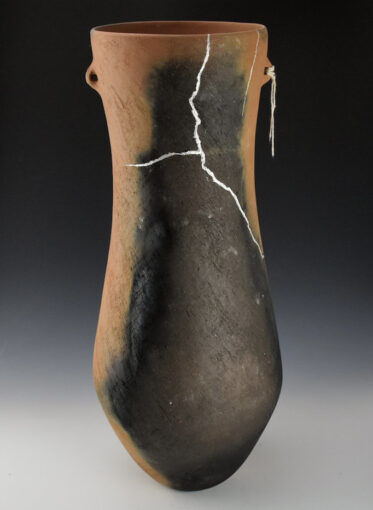
Yei jar – Alternate views.
At twenty-one inches tall, Jared Tso’s Yei Jar is immediately striking. However, the piece is visually interesting for other elements beyond its height. Of particular interest is a Yei-Bei-Che figure (correctly called a Yei) incised into the piece. The term Yei-Bei-Che (also written as Yeibichei and Yébîchai) is usually translated into English as meaning “the Holy People,” but can also mean “Grandfather” or “Paternal Gods”. There are, in fact, male and female Yei-Bei-Che. Some people mistakenly think that the Yei-Bei-Che are katsinas. They are not. Katsinas appear at Hopi and Zuni ceremonies. The Yei-Bei-Che are beings that appear at the Kléjê Hatál, or Night Chant, a major nine day Navajo healing ceremony that takes place under a very specific set of circumstances. The Night Chant integrates both religious and medical rituals. Masked dancers impersonate the Yei-Bei-Che in order to summon them to the earthly realm. In particular, three main Yei are represented: Haschéltî (Talking God), Haschbaád (Goddess) and Haschélapai (Gray God). It is believed that the masks worn by the dancers allows them to call the Yeis into the human world for the purpose of healing and guidance. These holy beings act as mediators between humans and the Great Spirit; they preside over the weather and the cycle of day and night and, as such, can be forces for good or ill.
Tso has chosen to portray the Yei on his jar with arms raised and palms facing outward as they are most often represented on Navajo rugs. In addition to the carved figure, the jar’s surface has beautiful blushes and dynamic fire clouds, both of which are the product of traditional firing. As if this weren’t enough to command the viewer’s attention, a forked line of silver makes its way around the piece alluding to lightning or, perhaps, water since there are small handles on the jar’s neck reminiscent of classic Navajo water jars.
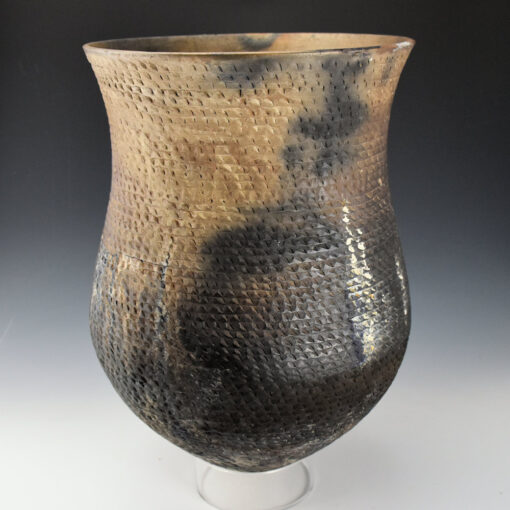
Corrugated Indigo Jar by Jared Tso, Navajo, traditional clay, pit fired, indigo dye, 9.5”w x 12”h (2021). Private collection.
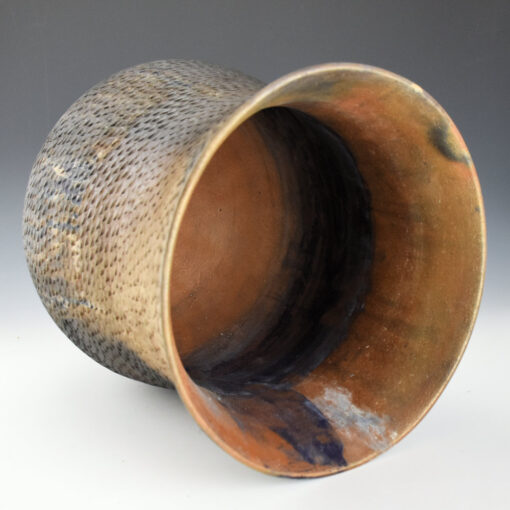
Corrugated Indigo Jar – Interior
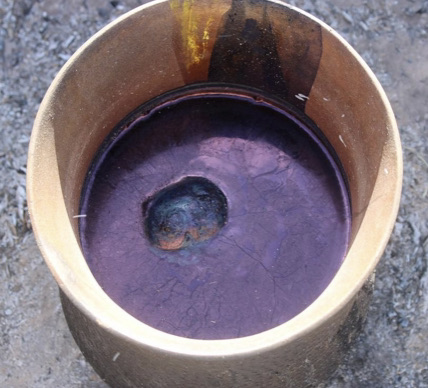
Corrugated Jar with dye and wool.
The strange beauty of Jared Tso’s Corrugated Indigo Jar draws on the form of historic Navajo utilitarian pots – those that had been constructed for cooking, storing foodstuffs, and carrying water. The jar’s surface contains hundreds of indentations, which capture light and attract the eye. Known as “pinching,” this technique has been used as a decorative device by Native Americans, particularly on functional pottery, since ancient times. Pots made in this style are said to be corrugated. The visual appeal of such pieces comes from the scores of tiny depressions and raised areas created by the artist in the clay before firing.

Jared Tso dyeing wool in his Corrugated Indigo Jar.
According to Charles King, “He [Tso] made the jar and then they went out to the sheep herds and they decided to dye wool. First, they tried lichen dye, but the pottery is too alkaline and it wouldn’t hold. THEN, they decided to do indigo. So they heated up the water in the jar, put in the indigo, and then dyed the wool. There is still some indigo on the inside.”
Tso’s Corrugated Indigo Jar is a minimalist exploration of form, but also of hue because of the fire clouds and color of the interior. It is a departure from what most people familiar with Native American pottery of the Southwest have come to expect. Charles King remarked further, “It’s just so well built . . . .’
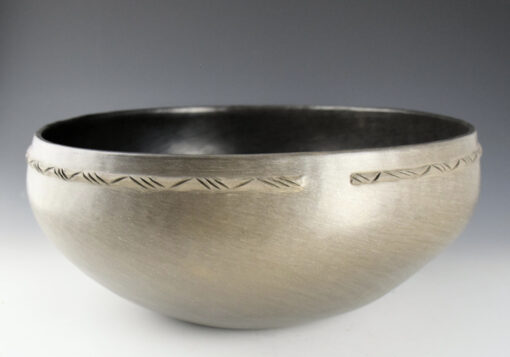 Łeets’aa’ Nímazí Zhinee’ Open Bowl with Swirling Polish by Jared Tso, Navajo, traditional clay, reduction fired, 14”w x 6”h (2020). Private collection.
Łeets’aa’ Nímazí Zhinee’ Open Bowl with Swirling Polish by Jared Tso, Navajo, traditional clay, reduction fired, 14”w x 6”h (2020). Private collection.
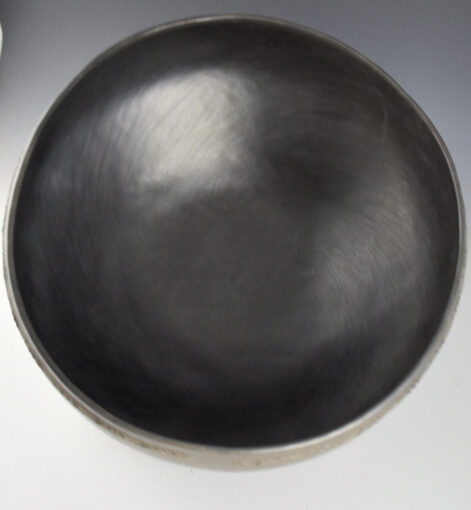
Łeets’aa’ Nímazí Zhinee’ Open Bowl with Swirling Polish – Interior.
Jared Tso’s Open bowl with Swirling Polish is one of the artist’s most elegant creations. Around the bowl’s rim, there is a band of raised clay with incised designs, which reference traditional Navajo pottery. The piece was reduction fired, which created a grayish coloration that appears silver to the human eye. The exterior of the bowl was polished in a swirling fashion while the interior is a nearly metallic black. Open Bowl with Swirling Polish is one of the artist’s most subtlety sophisticated creations.
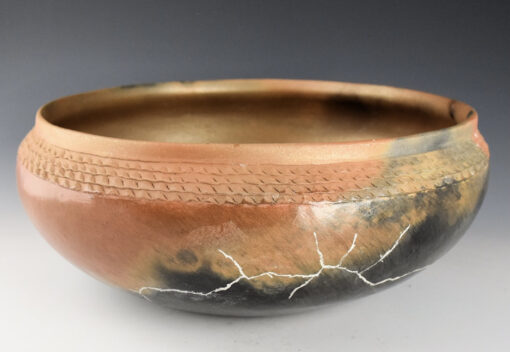
Bowl with Corrugated Rim and Silver “River” by Jared Tso, Navajo, micaceous clay, red slip, piñon pitch, silver adhesive, pit fired, 12”w x 5”h (2021). Private collection.
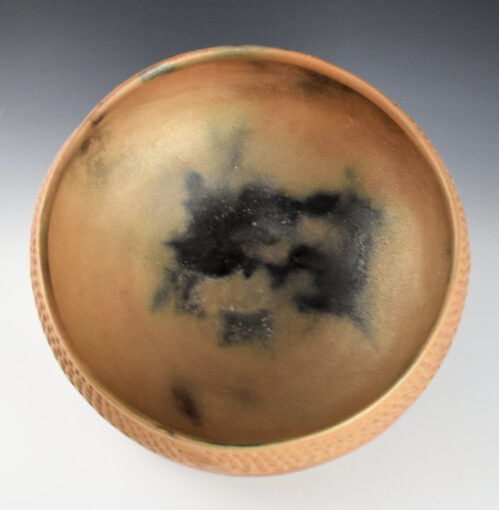
Bowl with Corrugated Rim and Silver “River” – Interior.
Jared Tso’s Bowl with Corrugated Rim and Silver “River” is another of the artist’s works that is made from micaceous clay. The bowl’s shoulder is defined by three corrugated bands, which are precise in their formation. The pit firing of the piece created lovely blushes as well as remarkable fire clouds. Perhaps the bowl’s most distinctive and dramatic feature is its silver inset, which suggests a vast river and its tributaries. This bowl is a testament to the artist’s inventiveness and willingness to experiment.
Until fairly recently, Navajo pottery was considered folk art until Alice Cling took it in a new and exciting direction. Her pieces are noted for being highly polished and having spectacular fires clouds. Collectors responded positively and other members of her family soon followed suit. Jared Tso has taken Navajo pottery to yet another level of artistry. Although Tso’s work draws on Navajo pottery practices such as using traditional clays, piñon pitch, and historic Navajo pottery forms, his work is profoundly contemporary. He is a new and unique voice among ceramic artists.
All photos are courtesy of King Galleries. The author would like to thank Charles King for his invaluable help with this article.
